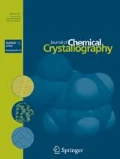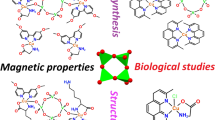Abstract
Two transition metal salts (manganese and cobalt) of the nedocromil were prepared, and their crystal structures were elucidated in an attempt to study the influence of the nature of the bivalent cation on the structure, water interactions, and molecular packing. Crystal data: nedocromil manganese pentahydrate (NMn), triclinic, P \(\overline 1\), a = 7.5351(4) Å, b = 10.3210(6) Å, c = 13.9664(8) Å, α = 86.640(1)°, β = 80.880(1)°, γ = 77.498(1)°, Z = 2; nedocromil cobalt heptahydrate (NCo), monoclinic. P21, a = 11.7847(2) Å, b = 7.0177(2) Å, c = 14.0700(1) Å, β = 105.343(1)°, Z = 2. Both Mn2+ and Co2+ have octahedral coordination, but the coordination environments of the cations and the bonding environments of the water molecules differ. In NMn, Mn2+ is octahedrally coordinated to two carboxylate oxygens, one in a syn orientation and the other in an anti orientation in a different asymmetric unit, and to four water molecules. In NCo, Co2+ is octahedrally coordinated to the carbonyl oxygen of the pyridone ring and to five water molecules. In NMn and NCo, the molecular conformations of the nedocromil anion are similar, with the carboxylate group on C2 almost in the same plane as the tricyclic ring, whereas the group on C8 is twisted out of the tricyclic plane. Thermal analytical data for NMn show that the water molecules in this hydrate are lost in two steps, of 4 mol and 1 mol of water, respectively. NCo also gave two dehydration steps but of about 6 mol of water and 1 mol of water, respectively.
Similar content being viewed by others
References
Cairns, H.; Cox, D.; Gould, K.J.; Ingall, A.H.; Suschitzky, J.L. J.Med.Chem. 1985, 28, 1832–1842.
Khankari, R.K. Physicochemical Characterization and Thermodynamic Properties of Nedocromil Salt Hydrates, Ph.D. Thesis; University of Minnesota: Minneapolis, MN, 1993; pp 40–148.
Hickey, A.; Martonen, T. Pharm.Res. 1993, 10, 1–7.
Chan, H.; Gonda, I. J.Pharm.Sci. 1995, 84, 692–696.
Forbes, R.T.; York, P.; Fawcett, V.; Shields, L. Pharm.Res. 1992, 9, 1428–1435.
Hirsch, C.A.; Messenger, R.J.; Brannon, J.L. J.Pharm.Sci. 1978, 67, 231–236.
Khanhari,R.K.; Grant,D.J.W.Pharm.Res.1991,8(Suppl.),S103.
Ojala, W.H.; Khankari, R.K.; Grant, D.J.W.; Gleason, W.B. J.Chem.Cryst. 1996, 26, 167–178.
Zhu, H.; Halfen, J.A.; Young, V.G., Jr; Padden, B.E.; Munson, E.R.; Menon, V.; Grant, D.J.W. J.Pharm.Sci. 1997, 86, 1439–1447.
Zhu, H.; Young, V.G., Jr; Grant, D.J.W. Int.J.Pharm. 2002, 232, 23–33.
Jones, P.G. Chem.Br. 1981, 17, 222–225.
SHELXTL-Plus V5.0; Siemems Industrial Automation: Madison, WI. 1996.
Carrell, D.J.; Carrell, J.E.; Glusker, J.P. J.Am.Chem.Soc. 1988, 111, 8651–8656.
Peterson, M.R.; Csizmadia, I.G. J.Am.Chem.Soc. 1979, 101, 1076–1079.
Author information
Authors and Affiliations
Rights and permissions
About this article
Cite this article
Zhu, H.(., Young, V.G. & Grant, D.J. Crystal structures and thermal analysis of nedocromil bivalent metal salt hydrates. Journal of Chemical Crystallography 31, 421–434 (2001). https://doi.org/10.1023/A:1015679519165
Issue Date:
DOI: https://doi.org/10.1023/A:1015679519165




